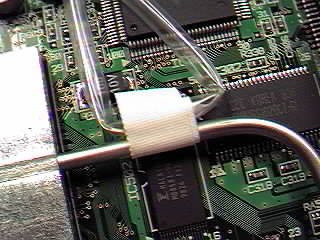|
|
|
| Well, we opened the dreamcast up and had a poke around. Found the usual things, some odd things, and some really unexpected things. Here's what we saw, and what we made of what we saw. | |
|
To start with, the construction of the unit is very similar to the
Sega Saturn. The power supply unit (PSU), the mainboard, controller-subboard
and drive unit are very reminiscent of the Saturn.
Everything internal is labelled KATANA. From the GD mech to the main board, the Katana label is everywhere. Looks like that was the official in-house name for the unit right up to the very end. ![[Katana Main Board]](katanamb.jpg)
|
|
There was one odd thing we noticed underneath the board. There's
a wire attached to one of six points - No idea what for.
![[Who knows?]](region.jpg)
|
|
The CD mech is labelled Katana GD (probably for gig, or giga, referring
to the gigabyte CD ROM mechanism). It's very robust, and is on an
enclosed board attached to the mainboard by an expansion-port-like
connector. It was, according to the label, manufactured by Yamaha.
![[CD Mech Connector]](cdmechcon.jpg)
|
|
The battery is hardwired - there's no easy changing of this
puppy like there was on the Saturn. Kind of an odd choice,
we would have thought, but there it is. This battery is used
exclusively for the internal clock, and to maintain the
internet information setup.
![[The hardwired Battery]](battery.jpg)
|
|
The CD Door switch was located deep inside the system, and probably
won't allow you to bypass it without opening the system, and either
wiring it closed or adding an external switch.
![[CD Door Switch]](cddoorswitch.jpg)
|
|
The most fascinating thing was the heat dissipation system. There
is the fan in the front, which everyone knows about. What's odd
is that it's nowhere near the two chips that get hot, located in
the middle of the mainboard.
[NEW 01/2000] The north american system does NOT use this
cooling method - where's the fun in that?
![[The Main Board]](mainboard.jpg)
![[Chip Heat Sink]](heatsinkchip.jpg)
![[Fan/HeatSink Unit]](heatsink1.jpg)
And as an added bonus, there's a thermistor attached to one of the cooling rods to measure the temperature, probably attached to a cut-off in case of overheating. 
Then there's the power supply. It's been designed, according
to the label, for voltages ranging from 85 to 132 AC. This means that
there is absolutely no problems running them in North America - they're
designed for it. No silly step-down transformers are needed.
|
![[85 - 132v AC]](85132.jpg)
The Saturn-like design is consistant throughout - this connector from the PSU to the mainboard is almost identical to the Saturn design. ![[Power Connector]](powercon.jpg)
|
|
All contents (c)1999 Game Station X unless otherwise noted. All trademarks copyright of their respective companies. Game Station X assumes absolutely no responsiblility whatsoever for any sort of damages incurred while either viewing this information or doing anything with said information. If you don't like it, change the channel. Some of this information may have come from other sources, and Game Station X in no way implies ownership of this information, and merely intends to provide a convenient source for finding this information. That said, we wrote this, and would appreciate your not lifting it for your own page without due credit. Mail us! |
